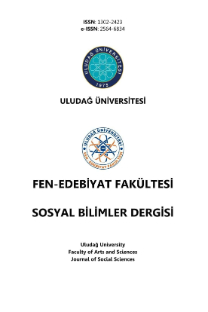A. ADNAN SAYGUN’UN OP.31 “PARTİTA” ADLI SOLO VİYOLONSEL (IV. BÖLÜM) ESERİNİN GEOMETRİK MODELLEMESİ
Geometric Modeling of The Solo Cello (Part IV) Works by A. Adnan Saygun’s Op.31 “Partita”
___
- Ahmet Adnan Saygun. https://tr.wikipedia.org/wiki/Ahmet_Adnan_Saygun https://www.turkcebilgi.com/ahmet_adnan_saygun (Erişim: 11.06.2019).
- Atalay, Bülent (2006). Matematik ve Mona Lisa. İstanbul: Albatros kitabevi.
- Bakım, Sümeyye (2014). Fibonacci Dizisi Ve Altın Oranın Müzik Kullanımının İncelenmesi. Yüksek Lisans Tezi. Konya: Selçuk Üniversitesi.
- Bayram, Nuran (2004). Sosyal Bilimlerde SPSS ile Veri Analizi. Bursa: Ezgi Kitabevi.
- Beytekin, Selen (2015). Cazın Piyano Üzerinden Matematiksel Analiz ile Fraktal Geometri ile İlişkisinin Analizi. Yüksek Lisans Tezi, İstanbul: İstanbul Teknik Üniversitesi.
- Bigerelle, Masence ve Alain Iost (2000). Fractal Dimension and Classification of Music. Chaos Solitons & Fractals, S. 11, s. 2179 - 2192.
- Büyüköztürk, Şener (2002). Sosyal Bilimler İçin Veri Analizi El Kitabı. Ankara: Pegem Akademi Yayıncılık.
- Demirbatır, Rasim Erol vd. (2018). “Matematiksel Kodlama Yoluyla A. Adnan Saygun’un ‘İnci’ Adlı Piyano Parçasının Geometrik Modellemesi”. Uluslararası Necatibey Egitim ve Sosyal Bilimler Arastırmaları Kongresi Tam Metin Bildiri Kitabı, s. 483-492.
- Devlin, Keith (2000). The Math Gene: How Mathematical Thinking Evolved and Why Numbers Are Like Gossip. Great Britain: Basic Books.
- Doğangün, Deniz (2015). “Ahmed Adnan Saygun’un Op.31 ‘Viyolonsel İçin Solo Partita’sı ve Eserin 1955 Türkiye’si Sanat Hayatındaki Yeri”. İnönü University Journal of Culture and Art, C. 1, S. 1, s. 61-69.
- Gülsoy, Filiz vd. (2013). “Mathematical and Statistical Modeling of the Musical Compositions”. Balkan Journal of Mathematics, S. 1, s. 35-43.
- Kıratlı Soyberk, Duygu (2016) Ahmet Adnan Saygun’un ‘Viyolonsel İçin Partita’ Adlı Eserinin Teknik İncelenmesi. Yüksek Lisans Tezi. Sivas: Cumhuriyet Üniversitesi.
- Koçak, Zeynep Fidan vd. (2014). “Estetik ve Matematik” https://www.researchgate.net/publication/267371356 Koshy, Thomas (2001). Fibonacci and Lucas Numbers with Applications. Canada: Wiley-Interscience Publication, s. 6-38.
- Lehmann, Ingmar ve Alfred Posamentier (2007). The (Fabulous) Fibonacci Numbers. Prometheus Books, s. 271-291.
- Mann, Alfred ve Jon Newsom (2000). Music History from Primary Sources, Washington: Library of Congress.
- Orhan, Cihan (1995). Matematik ve Müzik. Matematik Dünyası, s. 6-7. Rehding, Alexander (2003) Hugo Riemann and the birth of Modern Musical Thought. Cambridge University Press.
- Riedweg, Christoph (2005). Pythagoras: His Life, Teaching and Influence. Cornell University Press.
- Uçan, Ali (1994). Müzik Eğitimi Temel Kavramlar-İlkeler-Yaklaşımlar. Ankara: Müzik Ansiklopedisi Yayınları.
- Wright, David (2009). Mathematics and Music. Department of Mathematics, Washington University, St. Louis, s. 6-13.
- ISSN: 1302-2423
- Yayın Aralığı: 2
- Başlangıç: 1999
- Yayıncı: Bursa Uludağ Üniversitesi
FERMAN VE BERATLARA GÖRE 1603-1604 TARİHİNDE BURSA VE KİTE KAZALARININ DEVLET MERKEZİ İLE İLİŞKİLERİ
OBUA KAMIŞININ TÜRKİYE’DEKİ YETİŞME ALANLARI
A. ADNAN SAYGUN’UN OP.31 “PARTİTA” ADLI SOLO VİYOLONSEL (IV. BÖLÜM) ESERİNİN GEOMETRİK MODELLEMESİ
R. Erol DEMİRBATIR, Filiz YAĞCI, RIDVAN EZENTAŞ
DEMOKRASİLERDE DARBE GEÇİRMEZLİĞE YAKINDAN BAKMAK: SİVİL-ASKER İLİŞKİLERİNDE İSPANYA ÖRNEĞİ
TRAFİK DENEYİMLERİ VE DÜZEN SÖYLEMİ İÇİNDEN İSTANBUL’U ÜRETMEK
ZAMİR /N/’SİNİN TÜRKÇEDEKİ FONEMORFOLOJİK GELİŞİMİ
TRADITIONS OF THE ENLIGHTENMENT AND ITS POLITICAL REFLECTIONS
TÜRKİYE’DE ULUSAL KİMLİK İNŞASI VE SİYASİ PARTİ KİMLİKLERİ
EMEKLİLİK FON YÖNETİCİLERİNİN YATIRIM İNANÇLARI ÜZERİNE YAZIN TARAMASI
